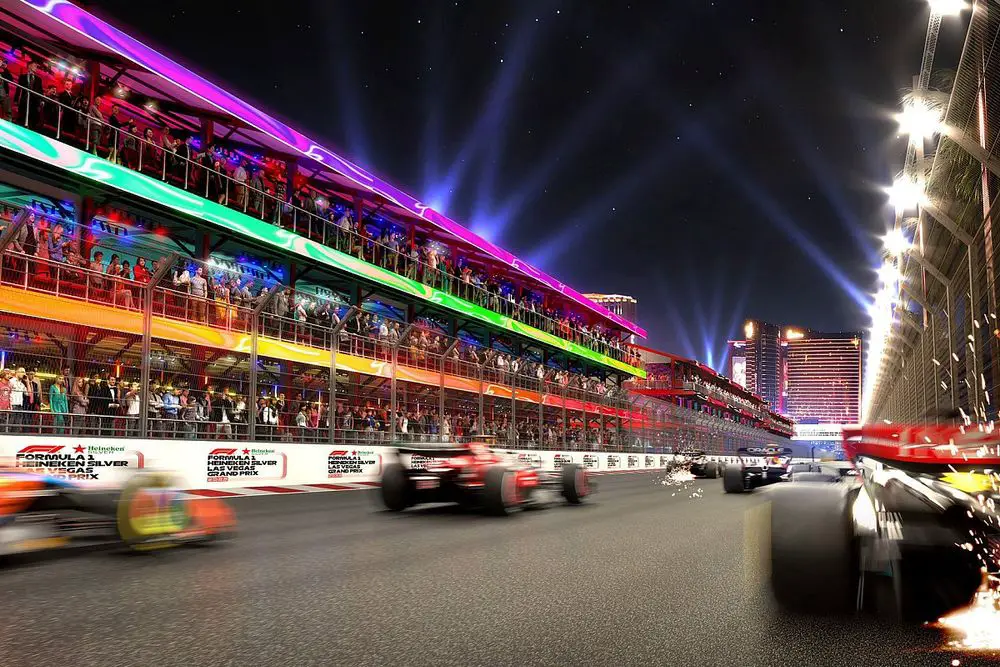Las Vegas Grand Prix 2023 Weather forecast – let us take a look at the weather forecast for the Las Vegas Grand Prix, scheduled to take place this weekend at the Las Vegas street circuit
Anticipate favorable weather in Las Vegas this weekend. The forecast indicates no chance of rain, with temperatures hovering around 22-23 degrees Celsius for optimal racing conditions. It’s worth mentioning that the FP1, FP2, and qualifying sessions on November 17 and 18 may encounter partly cloudy conditions.

Friday’s practice sessions are anticipated to unfold beneath overcast skies, with minimal rain prospects. Saturday promises a sunny, warm, and bright day, ensuring a smooth experience for participants. Similar conditions are projected for the main race on Sunday, with racing-friendly temperatures. Although the chance of rain on race day is relatively low, caution is advised due to the potential for swift weather changes. Fans and teams will be hopeful for a rain-free race weekend.
What’s the schedule for the 2023 Las Vegas GP?
Here’s how the schedule for the Las Vegas GP looks like:
Practice 1: Friday, November 17 – 10:00 IST
Practice 2: Friday, November 17 – 13:30 IST
Practice 3: Saturday, November 18 –10:00 IST
Qualifying: Saturday, November 18 – 13:30 IST
Race: Sunday, November 19 – 11:30 IST
Las Vegas – Climate Pattern
Las Vegas experiences a desert climate, characterized by hot summers and mild winters. Summers are extremely hot, with average high temperatures exceeding 100°F (38°C) in June, July, and August. Heatwaves are common, with temperatures occasionally soaring above 110°F (43°C). The city receives minimal rainfall during this period, contributing to the arid conditions.
Winters in Las Vegas are mild, with daytime temperatures ranging from the mid-50s to low 60s°F (13-17°C). While nights can be chilly, rarely dropping below freezing, overall, winter offers a respite from the scorching heat. The lack of significant precipitation persists during the winter months, contributing to the overall aridity of the region.

Spring and fall serve as transitional seasons, with more moderate temperatures. Spring sees a gradual warming, while fall experiences a cooling trend. Wind is a notable climatic feature, particularly in the spring, with occasional gusts impacting the region. These seasonal shifts contribute to variations in the outdoor experience, influencing tourism and local activities.
Las Vegas’ climate is heavily influenced by its location within the Mojave Desert, characterized by low humidity levels. While the city experiences ample sunshine throughout the year, the arid climate necessitates water conservation efforts, impacting landscaping practices and overall sustainability in the region.
Las Vegas Weather History in F1
Las Vegas has hosted Formula 1 races intermittently over the years, with varying weather conditions impacting the events. One notable race was the Caesars Palace Grand Prix, held in the 1980s. These races took place in the scorching heat of the Nevada desert, often experiencing temperatures well above 100°F (37.8°C). The extreme heat posed challenges for both drivers and cars, testing their endurance and reliability.
In 1981, the Caesars Palace Grand Prix witnessed particularly high temperatures, reaching around 110°F (43.3°C). The intense heat not only made driving physically demanding but also put a strain on the cars, leading to mechanical failures for some teams. Tire management became a crucial aspect of the race, as the hot track surface added stress to the rubber compounds.

On the other hand, the 1982 edition faced a different challenge – rain. Uncommon for the region, the race weekend saw unexpected rainfall, turning the typically dry track into a slippery surface. This posed a unique set of challenges for the teams, as they had to adapt their strategies to the changing weather conditions. The wet race added an element of unpredictability, creating opportunities for some drivers to showcase their skills in challenging circumstances.
More Formula One news:
- LAS VEGAS GRAND PRIX 2023 PREDICTIONS, PREVIEW, SCHEDULE, AND LIVE STREAM DETAILS
- F1 FANTASY LAS VEGAS 2023: PICKS THIS WEEK
- LISSIE MACKINTOSH NET WORTH 2023, MARRIAGE, F1 CAREER AND MORE
Follow our dedicated Formula One page for instant Formula One news and updates
